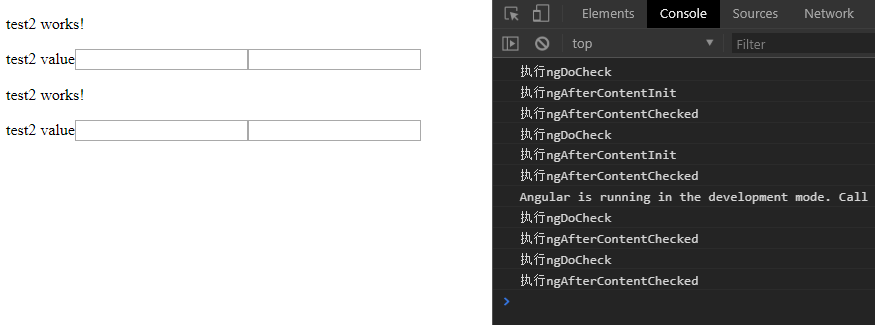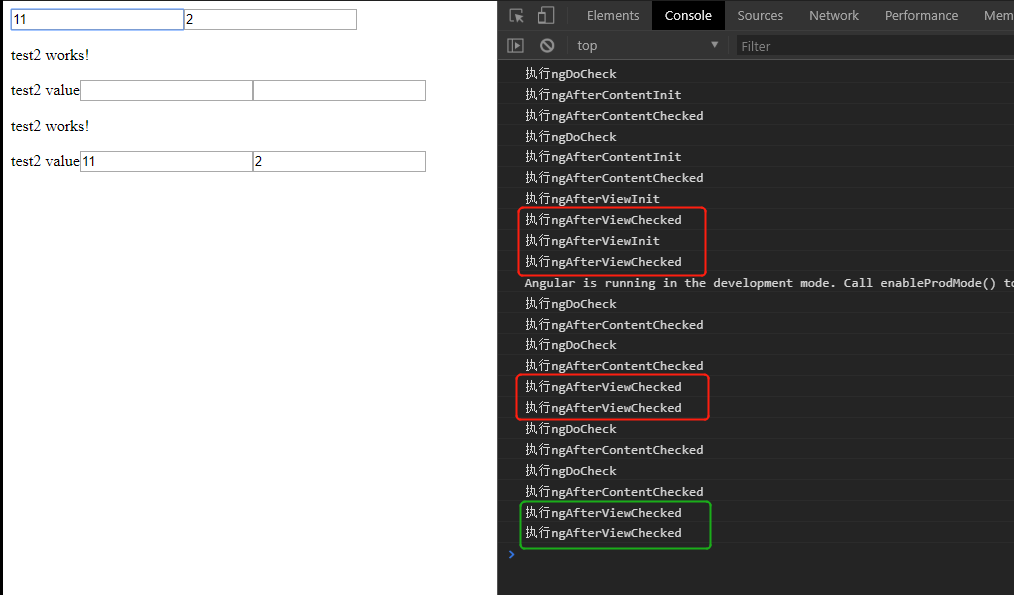Angular 個人深究(四)【生命週期鉤子】
Angular 個人深究(四)【生命週期鉤子】
定義:
每個元件都有一個被 Angular 管理的生命週期。
Angular 建立它,渲染它,建立並渲染它的子元件,在它被繫結的屬性發生變化時檢查它,並在它從 DOM 中被移除前銷燬它。
Angular 提供了生命週期鉤子,把這些關鍵生命時刻暴露出來,賦予你在它們發生時採取行動的能力。
除了那些元件內容和檢視相關的鉤子外,指令有相同生命週期鉤子。
概覽:
| ngOnChanges() | 當 Angular(重新)設定資料繫結輸入屬性時響應。 該方法接受當前和上一屬性值的 SimpleChanges 物件 當被繫結的輸入屬性的值發生變化時呼叫,首次呼叫一定會發生在 |
| ngOnInit() | 在 Angular 第一次顯示資料繫結和設定指令/元件的輸入屬性之後,初始化指令/元件。 在第一輪 |
| ngDoCheck() | 檢測,並在發生 Angular 無法或不願意自己檢測的變化時作出反應。 在每個 Angular 變更檢測週期中呼叫, |
| ngAfterContentInit() | 當把內容投影進元件之後呼叫。 第一次 |
| ngAfterContentChecked() | 每次完成被投影元件內容的變更檢測之後呼叫。
|
| ngAfterViewInit() | 初始化完元件檢視及其子檢視之後呼叫。 第一次 |
| ngAfterViewChecked() | 每次做完元件檢視和子檢視的變更檢測之後呼叫。
|
| ngOnDestroy() | 當 Angular 每次銷燬指令/元件之前呼叫並清掃。 在這兒反訂閱可觀察物件和分離事件處理器,以防記憶體洩漏。 在 Angular 銷燬指令/元件之前呼叫。 |
範例:
ngOnChanges()、ngInit
test2.component.ts
// test2.component.ts:
import { Component, OnInit,Input } from '@angular/core'; @Component({ selector: 'app-test2', templateUrl: './test2.component.html', styleUrls: ['./test2.component.css'] })
//需要繼承 OnInit、OnChanges 介面 export class Test2Component implements OnInit OnChanges{
// 兩個input 來自 父元件 test1 @Input() test2_value1: string; @Input() test2_value2: string; constructor() { } ngOnInit() {
//判斷 ngOnInit的執行順序 console.log("這裡執行ngOnInit"); } ngOnChanges(changes:SimpleChanges){ console.log(changes); for (let propName in changes) { let chng = changes[propName]; let cur = JSON.stringify(chng.currentValue); let prev = JSON.stringify(chng.previousValue); console.log(`${propName}: 新值 = ${cur}, 舊值 = ${prev}`); } } }
test1.component.html
<!-- test1.component.html --> <p> test1 works! </p> <label> test1 value</label> <input type="text" [(ngModel)]="test1_value1" > <input type="text" [(ngModel)]="test1_value2" > <!-- 將test1_value1的值給test2_value1... --> <app-test2 [test2_value1]="test1_value1" [test2_value2]="test1_value2"></app-test2>
結果:

說明:
- 剛重新整理頁面時,將test2_value1、test2_value2的值 從 undefined 變成 1、2。
- 頁面更改test1_value1,將test2_value1的值 從 1 變成 11。
- 以此類推, 可以使用 ngOnChanges對值發生變化時進行處理。
- ngInit 的執行順序在 ngOnChanges之後,可以做一下初始化的工作
ngDoCheck()
test2.component.ts
import { Component, OnInit,Input,OnChanges,DoCheck} from '@angular/core';
@Component({
selector: 'app-test2',
templateUrl: './test2.component.html',
styleUrls: ['./test2.component.css']
})
//需要實現 DoCheck 介面
export class Test2Component implements OnInit OnChanges DoCheck{
@Input() test2_value1: string;
@Input() test2_value2: string;
constructor() { }
ngOnInit() {
//console.log("這裡執行ngOnInit");
}
ngOnChanges(changes:SimpleChanges){
//console.log(changes);
for (let propName in changes) {
let chng = changes[propName];
let cur = JSON.stringify(chng.currentValue);
let prev = JSON.stringify(chng.previousValue);
//console.log(`${propName}: 新值 = ${cur}, 舊值 = ${prev}`);
}
}
ngDoCheck(){
console.log("執行ngDoCheck");
}
}
結果:

說明:
- 重新整理頁面的時候,執行了兩次。
- 每次滑鼠放到,input框上就會執行一次
- 更改input值,也會執行一次,開銷非常大。慎用!
ngAfterContentInit()
app.component.ts
import { Component } from '@angular/core';
@Component({
selector: 'app-root',
//templateUrl: './app.component.html',
//在app主組價中,將test2元件放到test1元件中,
template: `<app-test1>
<app-test2></app-test2>
</app-test1>`,
styleUrls: ['./app.component.css']
})
export class AppComponent {
title = 'app';
}
test1.component.ts
import { Component, OnInit,OnChanges} from '@angular/core';
@Component({
selector: 'app-test1',
//templateUrl: './test1.component.html',
//ng-content指定的是外來的元件 在元件app中定義的 test2元件
//同樣在test1元件中,也增加test2 元件
template: `<div> <ng-content></ng-content> <app-test2></app-test2> </div>`,
styleUrls: ['./test1.component.css']
})
export class Test1Component implements OnInit, OnChanges{
test1_value1:string;
test1_value2:string;
constructor() { }
ngOnInit() {
this.test1_value1="1"
this.test1_value2="2"
}
ngOnChanges(){
console.log("onchange");
}
}
test2.component.ts
import { Component, OnInit,Input ,OnChanges,DoCheck,SimpleChanges,AfterContentInit} from '@angular/core';
@Component({
selector: 'app-test2',
templateUrl: './test2.component.html',
styleUrls: ['./test2.component.css']
})
export class Test2Component implements OnInit,OnChanges,DoCheck,AfterContentInit{
@Input() test2_value1: string;
@Input() test2_value2: string;
constructor() { }
ngOnInit() {
//console.log("這裡執行ngOnInit");
}
ngOnChanges(changes:SimpleChanges){
//console.log(changes);
for (let propName in changes) {
let chng = changes[propName];
let cur = JSON.stringify(chng.currentValue);
let prev = JSON.stringify(chng.previousValue);
//console.log(`${propName}: 新值 = ${cur}, 舊值 = ${prev}`);
}
}
ngDoCheck(){
console.log("執行ngDoCheck");
}
ngAfterContentInit(){
console.log("執行ngAfterContentInit");
}
}
結果:

說明:
- ngAfterContentInit會在外來內容被投影到元件中之後 呼叫,也就是說當test2元件以html的形式投影到test1元件之後執行,
- 因為使用兩種方式進行投影了兩次,所以ngAfterContentInit執行了兩次
- 其他操作只會增加ngDoCheck的次數,並沒有增加ngAfterContentInit的次數
ngAfterContentCheck()
test2.component.ts
import { Component, OnInit,Input ,OnChanges,DoCheck,SimpleChanges,AfterContentInit,AfterContentCheck} from '@angular/core';
@Component({
selector: 'app-test2',
templateUrl: './test2.component.html',
styleUrls: ['./test2.component.css']
})
export class Test2Component implements OnInit,OnChanges,DoCheck,AfterContentInit,AfterContentCheck{
@Input() test2_value1: string;
@Input() test2_value2: string;
constructor() { }
ngOnInit() {
//console.log("這裡執行ngOnInit");
}
ngOnChanges(changes:SimpleChanges){
//console.log(changes);
for (let propName in changes) {
let chng = changes[propName];
let cur = JSON.stringify(chng.currentValue);
let prev = JSON.stringify(chng.previousValue);
//console.log(`${propName}: 新值 = ${cur}, 舊值 = ${prev}`);
}
}
ngDoCheck(){
console.log("執行ngDoCheck");
}
ngAfterContentInit(){
console.log("執行ngAfterContentInit");
}
ngAfterContentChecked(){
console.log("執行ngAfterContentChecked");
}
}
結果:

說明:
- 在執行ngDoCheck之後 一定會執行一次ngAfterContentInit
- 每次完成被投影元件內容的變更檢測之後呼叫
- 其他程式碼沒貼出來,就是跟上一個是一樣的
ngAfterViewInit()
test1.component.ts
import { Component, OnInit,OnChanges,ViewChild} from '@angular/core';
import {Test2Component} from "../test2/test2.component"
@Component({
selector: 'app-test1',
//templateUrl: './test1.component.html',
template: `<div> <input type="text" [(ngModel)]="test1_value1" >
<input type="text" [(ngModel)]="test1_value2" ><ng-content></ng-content>
<app-test2 [test2_value1]="test1_value1" [test2_value2]="test1_value2"></app-test2> </div>`,
styleUrls: ['./test1.component.css']
})
export class Test1Component implements OnInit, OnChanges{
test1_value1:string;
test1_value2:string;
constructor() { }
@ViewChild(Test2Component);
ngOnInit() {
this.test1_value1="1"
this.test1_value2="2"
}
ngOnChanges(){
console.log("onchange");
}
}
test2.component.ts
import { Component, OnInit,Input ,OnChanges,DoCheck,SimpleChanges,AfterContentInit,AfterContentCheck, AfterViewChecked, AfterViewInit} from '@angular/core';
@Component({
selector: 'app-test2',
templateUrl: './test2.component.html',
styleUrls: ['./test2.component.css']
})
export class Test2Component implements OnInit,OnChanges,DoCheck,AfterContentInit,AfterContentCheck ,AfterViewChecked, AfterViewInit{
@Input() test2_value1: string;
@Input() test2_value2: string;
constructor() { }
ngOnInit() {
//console.log("這裡執行ngOnInit");
}
ngOnChanges(changes:SimpleChanges){
//console.log(changes);
for (let propName in changes) {
let chng = changes[propName];
let cur = JSON.stringify(chng.currentValue);
let prev = JSON.stringify(chng.previousValue);
//console.log(`${propName}: 新值 = ${cur}, 舊值 = ${prev}`);
}
}
ngDoCheck(){
console.log("執行ngDoCheck");
}
ngAfterContentInit(){
console.log("執行ngAfterContentInit");
}
ngAfterContentChecked(){
console.log("執行ngAfterContentChecked");
}
ngAfterViewInit(){
console.log("執行ngAfterViewInit");
}
}
結果:

說明:
- 在每次建立了元件的子檢視後呼叫,每次在test1元件中建立test2元件時都會呼叫,
- 在test1元件中,需要使用@ChildView 裝飾器,將test2component裝飾一下
ngAfterViewChecked
test2.component.ts
import { Component, OnInit,Input ,OnChanges,DoCheck,SimpleChanges,AfterContentInit,AfterContentCheck, AfterViewChecked, AfterViewInit} from '@angular/core';
@Component({
selector: 'app-test2',
templateUrl: './test2.component.html',
styleUrls: ['./test2.component.css']
})
export class Test2Component implements OnInit,OnChanges,DoCheck,AfterContentInit,AfterContentCheck ,AfterViewChecked, AfterViewInit{
@Input() test2_value1: string;
@Input() test2_value2: string;
constructor() { }
ngOnInit() {
//console.log("這裡執行ngOnInit");
}
ngOnChanges(changes:SimpleChanges){
//console.log(changes);
for (let propName in changes) {
let chng = changes[propName];
let cur = JSON.stringify(chng.currentValue);
let prev = JSON.stringify(chng.previousValue);
//console.log(`${propName}: 新值 = ${cur}, 舊值 = ${prev}`);
}
}
ngDoCheck(){
console.log("執行ngDoCheck");
}
ngAfterContentInit(){
console.log("執行ngAfterContentInit");
}
ngAfterContentChecked(){
console.log("執行ngAfterContentChecked");
}
ngAfterViewInit(){
console.log("執行ngAfterViewInit");
}
ngAfterViewChecked(){
console.log("執行ngAfterViewChecked");
}
}
結果:

說明:
- 上圖紅色框是,頁面重新整理完後執行的ngAfterViewChecked,前兩次是伴隨init一起的,後面兩個是,test1給test2賦值導致的
- 上圖綠色框是,更改test1中的一個值,導致了更改了test2的值執行的ngAfterViewChecked
- 我再test1元件的兩個input上,滑鼠焦點來回切換時,同樣也會執行ngAfterViewChecked,還是慎用這個鉤子函式吧
OnDestroy
test1.component.ts
import { Component, OnInit,OnChanges,ViewChild} from '@angular/core';
import {Test2Component} from "../test2/test2.component"
@Component({
selector: 'app-test1',
//templateUrl: './test1.component.html',
template: `
<div>
<input type="text" [(ngModel)]="test1_value1" >
<input type="text" [(ngModel)]="test1_value2" >
<ng-content></ng-content>
<app-test2 [test2_value1]="test1_value1" [test2_value2]="test1_value2">
</app-test2>
<div *ngFor="let test of tests" appTest4 class="tests">
{{test}}
</div>
<input type="button"value="add" (click)="addDiv()">
<input type="button"value="delete"(click)="deleteDiv()">
</div>`,
styleUrls: ['./test1.component.css']
})
export class Test1Component implements OnInit, OnChanges{
test1_value1:string;
test1_value2:string;
tests:any;
constructor() { }
@ViewChild(Test2Component) viewChild:Test2Component;
ngOnInit() {
this.test1_value1="1"
this.test1_value2="2"
this.tests=[1,2,3]
}
ngOnChanges(){
console.log("onchange");
}
addDiv(){
this.tests.push("1212");
}
deleteDiv(){
this.tests=[];
}
}
test4.directive.ts
import { Directive, OnInit, OnDestroy } from '@angular/core';
@Directive({
selector: '[appTest4]'
})
export class Test4Directive implements OnInit, OnDestroy{
constructor() { }
ngOnInit() { console.log("test4 directive ngOnInit")}
ngOnDestroy() { console.log("test4 directive ngDestroy");}
}
結果:

說明:
- 建立一個directive來 監測test1 元件中的 div的生成與銷燬
- 開始有預設的三個值,所有ngOnInit執行了三次
- 新增一個值,又執行一次ngOnInit
- 刪除所有的值,執行了4次ngDestroy
總結:
由於生命週期的存在,angular提供了眾多的生命週期的鉤子,讓我們能夠很好的在發生變化的時候進行處理。
